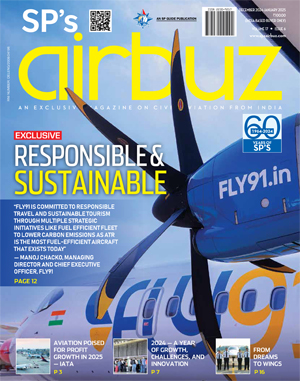Expanding Across Asia

Can AirAsia pull a rabbit out of the hat and shake up the Indian market as it promises or will this turn out to be another episode in the Great Indian Hope Trick?
With some luck coupled with some unusual alacrity on the part of normally laid-back Indian bureaucracy, AirAsia India should be ready to commence operations early next year. For better or for worse, it may mark a turning point in India’s airline industry. The AirAsia story began with AirAsia Berhad (AirAsia Malaysia) in 2001, which pioneered the low-cost carrier (LCC) model in Asia. It then went on to establish associate companies Thai AirAsia, Indonesia AirAsia, Philippines’ AirAsia and Air- Asia Japan. Thanks to these affiliates and AirAsia X, its long-haul joint venture, the AirAsia Group spread its tentacles across much of Asia and beyond. AirAsia’s vision “Now Everyone Can Fly” is wafted from its main hub, the low-cost carrier terminal at Kuala Lumpur International Airport, to about 85 destinations in some 20 countries, courtesy its large fleet of Airbus A320-200 aircraft.
AirAsia’s first three affiliates AirAsia Malaysia, Thai AirAsia and Indonesia AirAsia—all over seven years old—are profitable. It plans to expand these aggressively over the next few years to fend off increasing competition. But it also has two loss-making ventures in the Philippines and Japan. AirAsia Japan is in the process of winding up. Philippines’ AirAsia, at present only pint size, is unlikely to expand for some time. AirAsia India, still awaited, is potentially an enormously larger affair.
The Profitable Trio
With its fleet strength growing from 64 to 74 A320s, the year has been one of rapid expansion for the Kuala Lumpur-based AirAsia Malaysia. It currently competes with Malaysia Airlines and enjoys 60 per cent of the Malaysian market. For some years since its inception in 2001, its operating profit margin has been among the highest in the world. But now Malindo Air, partially owned by the Lion Air Group, is likely to provide it stiff competition and put pressure on yields.
Thai AirAsia has been in operation since February 2004. It shifted all operations to Don Mueang International Airport, Bangkok, from October 1, 2012. This helped it lower costs considerably and capture about 30 per cent domestic market share. On the international scene it has just seven per cent market share, second to Thai Airways. It already faces a worthy competitor Nok in the domestic market, and Nok recently entered the international market too. With 26 additional aircraft on order, Thai AirAsia is on track to achieve a fleet strength of 35 Airbus A320s by the year end. It has wiped out its cumulative loss and is now making a profit. It is also expanding flights to India, where it should prove useful as a feeder for AirAsia’s joint venture in India.
However, AirAsia’s Indonesian affiliate is still on somewhat shaky ground. Operating domestically from December 2004 under the name Awair and as Indonesia AirAsia since December 2005, the carrier’s main hub is Soekarno-Hatta International Airport, Jakarta. Indonesia is a large market but it is already crowded with several LCCs. Indonesia AirAsia is directly pitted against Lion Air, an LCC with an extremely low-cost structure and raging ambitions. After suffering losses for many years, Indonesia Air-Asia recently began to earn a profit but not enough to wipe out its accumulated losses. Its fleet is slated to grow to 30 A320s by the end of the year and it has another 32 planes on order.
The Loss-Making Two
Lest one think that everything AirAsia CEO Tony Fernandes touches turns into gold, the Philippines and Japan have not proved to be happy hunting grounds. Both these affiliates were added in 2012 after a gap of seven years. Like India, the Philippines market is plagued by over-capacity and crazy competition, with no less than five LCCs competing in the domestic space. AirAsia Philippines, which commenced operations in March 2012 with two Airbus A320 aircraft, accounts for just one per cent of domestic capacity. It appears to be in some trouble on account of its newly acquired, loss-making subsidiary AirAsia Zest. However, it intends to aggressively expand Zest’s current fleet of 13 aircraft. AirAsia Japan is a failure. Started with much fanfare in August 2012, it was a joint venture between AirAsia Berhad and All Nippon Airways (ANA), a Japanese full-service carrier. But it never stabilised and a little over a year after it started flying out of Tokyo’s Narita Airport, it ceased operations in October.
Emphasising Long-Haul
While AirAsia began as a short-haul airline, the company soon realised that there was money to be made in the low-cost, long-haul segment. So AirAsia X was launched in November 2007 from its main hub at Kuala Lumpur to provide high-frequency long-haul service. AirAsia X is not part of the AirAsia Group but has a licensing agreement that permits it to use the brand. It has made scant profit so far but early last year, after it decided to cease operating on unprofitable long-haul routes, mainly in Europe, New Zealand and India, its financial disposition has improved. With LCCs now accounting for over 50 per cent of traffic in South East Asia, AirAsia X has changed focus and decided to concentrate on medium-haul routes to the rest of the Asia-Pacific region. It has proved that the Australia-South East Asia market is ideally suited to its medium/long-haul low-cost model. By the end of this year, it should have a fleet of 16 A330-300s and two A340-300s and will add seven A330-300s next year. This should help it corner about 60 per cent of South East Asia’s medium- and long-haul low-cost market. AirAsia X also plans to launch Thai AirAsia X by end 2013.
Finally From India
In January 2013, Tony Fernandes publicly ruled out establishing any more AirAsia affiliates in South East Asia but promised to set up another joint venture somewhere in Asia, then call it quits for another five or ten years. It was easy to guess that India might be his choice since he has strong roots here. Thanks largely to AirAsia, aviation penetration in Malaysia surged dramatically from six per cent in 2001 to about 70 per cent in just ten years. Today, less than three per cent of Indians, mainly living in and around the metros, fly. Besides, India’s population is 40 times larger than that of Malaysia. So the potential for expansion of air services in this country is practically unlimited. Indeed, India is projected to become the world’s third largest aviation market by 2020.
AirAsia India, a 49:30:21 joint venture with the Tata Group and Telestra Tradeplace Pvt. Ltd, aims to start small with perhaps three Airbus A320 aircraft based at Chennai. Thereafter, it will aggressively add up to ten aircraft a year to its fleet. The carrier will not tread the beaten path but aims to open new markets and net new passengers. Using unfrequented airports, flying secondary routes, attracting first-time flyers and offering the lowest fares, that is AirAsia India’s winning formula. This should be music to the ears of large swathes of the population who have long been denied air links thanks to the preoccupation of airlines with inter-metro routes.
What Makes AirAsia Tick?
AirAsia was recently named the World’s Best Low Cost Carrier for the fifth consecutive year by Skytrax. Currently, the AirAsia Group has over 130 Airbus A320s plus five on lease. When its outstanding orders are fulfilled, it should reach a fleet strength of 475, comprising 264 Airbus A320neo and 211 A320 jets. This would put AirAsia among the top three LCC groups in the world. AirAsia believes that the key to delivering low fares is to keep costs under control through simplicity coupled with high efficiency in every part of the business. A single aircraft fleet means significant savings in training and maintenance and the Group’s cost structure is among the lowest in the world. According to the Centre for Asia Pacific Aviation (CAPA), the three airlines with the lowest cost-base in Asia are all AirAsia affiliates—AirAsia X, Indonesia AirAsia and AirAsia Berhad. AirAsia X has the lowest known cost-base in the world due to its low-cost philosophy coupled with its sole focus on flying wide-body jets on medium- and long-haul routes.
AirAsia aims for consistent high frequency and quick turnaround. It takes just 25 minutes to turnaround its planes, enabling it to record average aircraft utilisation of 12-14 block hours a day. The Group achieved an impressive load factor of 80 per cent for the quarter which ended on June 30, 2013.
But fears have been expressed that AirAsia may be overextending itself. Its affiliate in Japan is dead. Philippines’ AirAsia is limping along. There’s bound to be all-out war in Malaysia, Thailand and Indonesia as Lion Air, Malindo Air, Nok and others aggressively try to beat AirAsia at its own game. In India, too, the carrier will be up against stiff competition from well-set LCCs such as IndiGo, SpiceJet and GoAir, which have already boosted the country’s LCC market share to over 60 per cent. There’s also the formidable Tata-Singapore Airlines joint venture airline to contend with.
Can AirAsia pull a rabbit out of the hat and shake up the Indian market as it promises or will this turn out to be another episode in the Great Indian Hope Trick?





